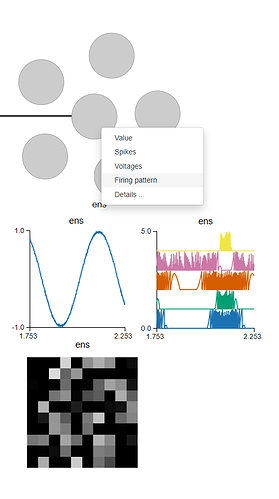Hi xchoo,
Thank you for the welcome back and quick reply! I’m using
nengo 3.0.0
python 3.5.2
nengo_gui 0.4.7
Your code worked fine on my setup. But the following code provides the error only when a voltage plots is on the gui, (i made one for ‘c’)
import nengo
from nengo.dists import Choice
import numpy as np
import pandas as pd
print(nengo.__version__)
seed = 0
sim_dt = 0.01
timeconstant = sim_dt * 1
model = nengo.Network()
with model:
input_a = nengo.Node([0.5], label="input_a")
input_b = nengo.Node([0.5], label="input_b")
in_a = nengo.Ensemble(n_neurons=1, dimensions=1,label="in_a", gain=1*np.ones(1), bias=2*np.ones(1),
neuron_type=nengo.LIF(tau_rc=timeconstant, tau_ref=sim_dt/10, min_voltage=0))
in_b = nengo.Ensemble(n_neurons=1, dimensions=1, label="in_b", gain=1*np.ones(1), bias=2*np.ones(1),
neuron_type=nengo.LIF(tau_rc=timeconstant, tau_ref=sim_dt/10, min_voltage=0))
nengo.Connection(input_a, in_a.neurons, transform=1)
nengo.Connection(input_b, in_b.neurons, transform=1)
d = nengo.Ensemble(n_neurons=1, dimensions=1, label="d", gain=1*np.ones(1), bias=1*np.ones(1),
neuron_type=nengo.LIF(tau_rc=timeconstant, tau_ref=sim_dt/10, min_voltage=0))
nengo.Connection(in_a.neurons, d.neurons, transform=[[1]])
nengo.Connection(in_b.neurons, d.neurons, transform=[[1]])
c = nengo.Ensemble(n_neurons=1, dimensions=1, label="c", gain=1*np.ones(1), bias=1*np.ones(1),
neuron_type=nengo.LIF(tau_rc=timeconstant, tau_ref=sim_dt/10, min_voltage=0))
nengo.Connection(in_a.neurons, c.neurons, transform=[[1]])
nengo.Connection(in_b.neurons, c.neurons, transform=[[1]])
Here is the error:
Traceback (most recent call last):
File “c:\users\micha.conda\envs\threefive2\lib\site-packages\nengo\builder\signal.py”, line 332, in getitem
return dict.getitem(self, key)
KeyError: Signal(name=<Neurons of <Ensemble “d”>>.voltage[(slice(None, 1, None),)], shape=(1,))
During handling of the above exception, another exception occurred:
Traceback (most recent call last):
File "c:\users\micha\.conda\envs\threefive2\lib\site-packages\nengo_gui\page.py", line 526, in runner
self.sim.step()
File "c:\users\micha\.conda\envs\threefive2\lib\site-packages\nengo\simulator.py", line 372, in step
self._probe()
File "c:\users\micha\.conda\envs\threefive2\lib\site-packages\nengo\simulator.py", line 252, in _probe
tmp = self.signals[self.model.sig[probe]["in"]].copy()
File "c:\users\micha\.conda\envs\threefive2\lib\site-packages\nengo\builder\signal.py", line 336, in __getitem__
base = dict.__getitem__(self, key.base)
KeyError: Signal(name=<Neurons of <Ensemble "d">>.voltage, shape=(1,))


